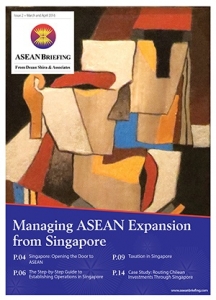China
China Introduces Wide-Sweeping New Transfer Pricing Rules
On June 29, China’s State Administration of Taxation (SAT) issued the “Announcement on the Administration of Related-party Transactions and Contemporaneous Documentation (SAT Announcement [2016] No. 42)”, which introduces a three-tiered documentation framework that will replace its current transfer pricing documentation rules.
The Announcement was released following the opinion-seeking draft publicized by the tax bureau in September 2015, and is largely consistent with the BEPS (Base Erosion and Profit Shifting) project launched by the Organization for Economic Cooperation and Development (OECD). Compared to the 2015 Draft – which has been discussed in our previous article – the Announcement revised some terms and further clarified the requirements for reporting companies, as well as the information they need to submit. Below, we provide a brief summary of the key information taken from the Announcement, and offer suggestions for multinational companies seeking to repatriate their profits from China to their headquarters.
Avoiding Labor Disputes in China: The Importance of the Staff Handbook
While a labor contract is vital in any employer-employee relationship, many employers overlook the importance of a having a staff handbook in China (also called an employee handbook or company rulebook). However, there are some key provisions that are not contained in standard contracts. While an employment contract details important terms such as working hours, salary, main duties and responsibilities, etc., key provisions such as overtime rules, codes of conduct, performance standards, promotion standards, and KPIs are often left out. This is where a staff handbook becomes beneficial, as they go into the finer and more individual rules of the company that all employees should be aware of. A staff handbook is an added layer of protection for the company and, while it is recommended for all foreign companies, it is especially crucial for growing companies with an employee count above ten.
India
India’s New National Education Policy Offers New Opportunities for Foreign Educational Institutions
The Ministry of Human Resources Development (MHRD) of the Government of India recently announced its intent to establish a new National Education Policy (NEP). The current policy has been unchanged since 1992. MHRD’s document, “Some Inputs for Draft National Education Policy 2016,” is open for public comment until July 31, 2016. The higher education aspects of the policy are of particular interest to foreign educational institutions.
According to a report written for MHRD, nearly 300,000 Indian students study abroad, mostly in post-graduate and doctorate programs, spending about US$ 9 billion per year. Nearly half of those 300,000 students go to the United States, with the United Kingdom and Australia accounting for most of the other destinations for studying abroad. Annual spending by Indians for foreign studies is twice the amount allocated in the central government budget for higher education, and nearly 20 times what Indian higher education institutions spend on research collectively. In contrast, only 75,000 foreign students come to India, many only for short duration study programs; less than 20,000 international students are enrolled in degree programs, most of them undergraduate students from South Asia.
India’s Goods and Services Tax Bill – A Critical Evaluation
The original blueprint of the Goods and Services Tax (GST) bill was first introduced in 2001. It aims to adopt a value added tax (VAT) model, and replace the current national-level central excise duty and state-level sales tax model. Heated debates in parliament has hindered the passage of the bill, which has been modified several times.
India’s current tax system is complex and multi-layered. Cross-border compliance, compounding of taxes on domestically produced goods and services, in addition to several central and state taxes, exacerbate the complexity of the system. This is why the government has realized the need for an efficient, transparent, and simple method of indirect taxation in the form of the GST bill. The bill indicates that the GST will be a tax on the final consumption or the actual supply of goods and services. The basic provision of the tax is that economic activity at each stage of production is taxed at the same rate, preventing further fragmentation. The GST will comprise of three main taxes: CGST (Central), SGST (State), and IGST (Inter-State). This article critically evaluates the bill. The first section looks at the benefits of the GST, the second section addresses the drawbacks of the GST, and the final section looks at how the GST will affect the landscape of the Indian economy.
Vietnam
Understanding Vietnamese Mergers and Acquisitions
As Vietnam increasingly becomes a hub for foreign businesses, the government is streamlining the mergers and acquisitions (M&A) process to encourage investment in new sectors of the economy. While establishing a business in Vietnam may prove too cumbersome for some hopeful entrants, the M&A route provides a unique solution to many of these obstacles. With this path, investors will enjoy preexisting access to consumers, locations, and distribution channels. This local knowledge can prove critical to successful operations within Vietnam’s vibrant but rapidly changing investment environment .
To successfully carry out M&As within Vietnam, it is important to recognize the legal foundation of current policies, and to understand the procedures and limitations associated with acquisitions in Vietnam.
ASEAN
ASEAN’s Sharing Economy: Understanding Opportunities and Navigating Regulations
As internet penetration rates continue to rise in Southeast Asia, ASEAN grows more interconnected by the day. Home to over 663 million inhabitants, the region is projected by many to be among the world’s most promising markets for a variety of internet based services. Chief among these are services involved in what has been coined the “sharing economy” – a loose collection of peer-to-peer services known to substantially lower costs for key necessities such as transport and accommodation.
In a 2014 study conducted by Nielsen, Indonesia and the Philippines ranked as two of the top five populations worldwide primed to participate in the sharing economy. While Indonesia ranked second in the study, with 87 percent of respondents reporting a willingness to utilize products within a sharing economy, the Philippines only trailed by two percentage points, earning fourth place.
|
Asia Briefing Ltd. is a subsidiary of Dezan Shira & Associates. Dezan Shira is a specialist foreign direct investment practice, providing corporate establishment, business advisory, tax advisory and compliance, accounting, payroll, due diligence and financial review services to multinationals investing in China, Hong Kong, India, Vietnam, Singapore and the rest of ASEAN. For further information, please email asia@dezshira.com or visit www.dezshira.com. Stay up to date with the latest business and investment trends in Asia by subscribing to our complimentary update service featuring news, commentary and regulatory insight. |
![]()
 The Asia Sourcing Guide 2015
The Asia Sourcing Guide 2015
In this issue of Asia Briefing, we explain how and why the Asian sourcing market is changing, compare wage overheads, and look at where certain types of products are being manufactured and exported. We discuss the impact of ASEAN’s FTAs with China and India, and highlight the options available for establishing a sourcing model in three locations: Vietnam, China, and India. Finally, we examine quality control in each of these markets.
 Managing ASEAN Expansion from Singapore
Managing ASEAN Expansion from Singapore
For the second issue of our ASEAN Briefing Magazine, we look at the benefits of using Singapore a hub for the management of regional operations throughout ASEAN. We firstly focus on the position of Singapore relative to its competitors, such as the Netherlands and Hong Kong. We then provide step-by-step instructions on corporate establishment, and provide expert insight on maximizing returns through the reduction respective tax burdens.
The 2015 Asia Tax Comparator
In this issue, we compare and contrast the most relevant tax laws applicable for businesses with a presence in Asia. We analyze the different tax rates of 13 jurisdictions in the region, including India, China, Hong Kong, and the 10 member states of ASEAN. We also take a look at some of the most important compliance issues that businesses should be aware of, and conclude by discussing some of the most important tax and finance concerns companies will face when entering Asia.



